With head coach Florian Kohfeldt, Werder Bremen have regained their consistency on the manager position which the club has become renowned for. However, in 2019/20 Bremen await a big challenge as their playmaker Max Kruse has left the club and therefore Werder will need to change their approach.
This tactical analysis deals with possible strategies to compensate for the loss of Kruse. Moreover, we will explain the tactical tweaks that Werder coach Florian Kohfeldt already implemented during pre-season.
Same system, new roles?
In general, Florian Kohfeldt established a centrally focused attacking play at Werder Bremen. Usually, Bremen would provide width with high full-backs while the central midfielders would use triangular shapes to provide central passing options. As one could see during pre-season, Bremen will stick to this style of play.
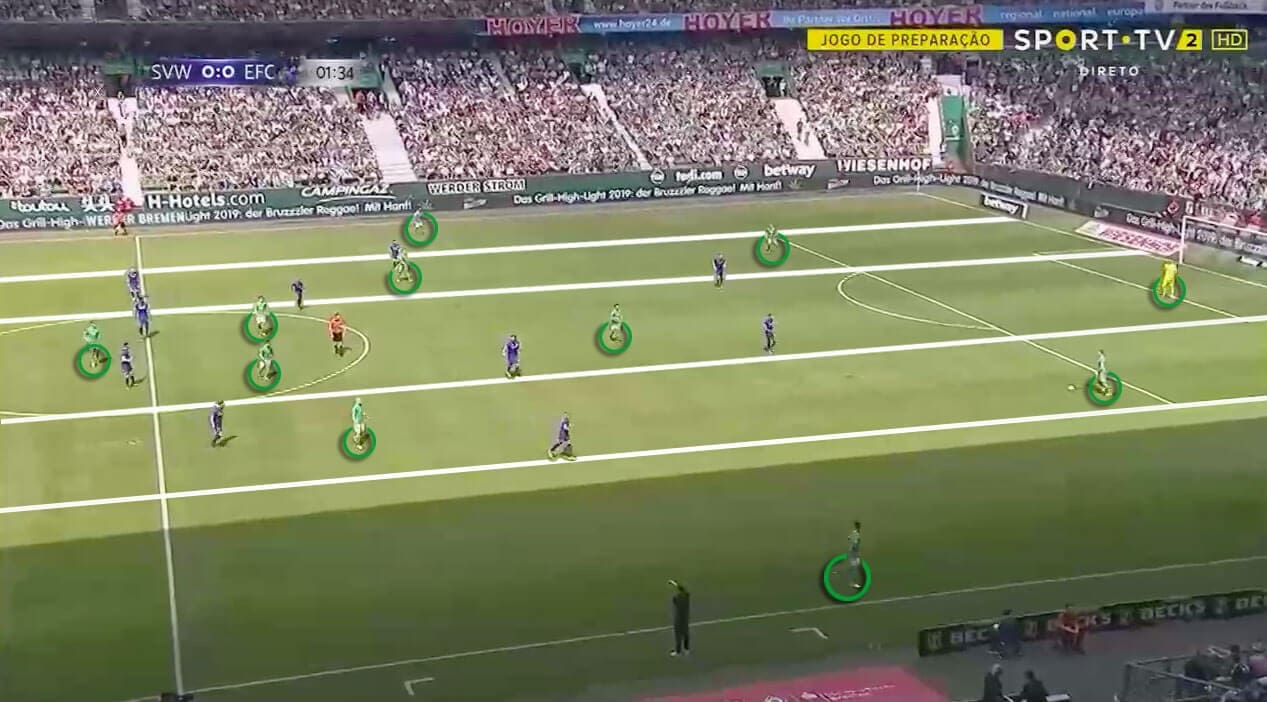
One of Bremen’s key players in 2019/20 might be Nuri Sahin who will take over more responsibility in midfield. Contrary to last season, Sahin has been with the squad for the whole of pre-season which has allowed Kohfeldt to bank on the playmaking abilities of the Turkish midfielder from the first day on. In a midfield diamond or triangle, Sahin could utilise his passing qualities and provide a central passing option during build-up play.
Although Bremen lost their playmaker, Japanese Yuya Osako might replace Kruse. That would mean that Werder stick to their typical 4-3-3 with a false nine nominally lined up as the centre-forward. In this case, Osako would drop into midfield forming a diamond while the two wide forwards tuck inside and act as a striking duo.
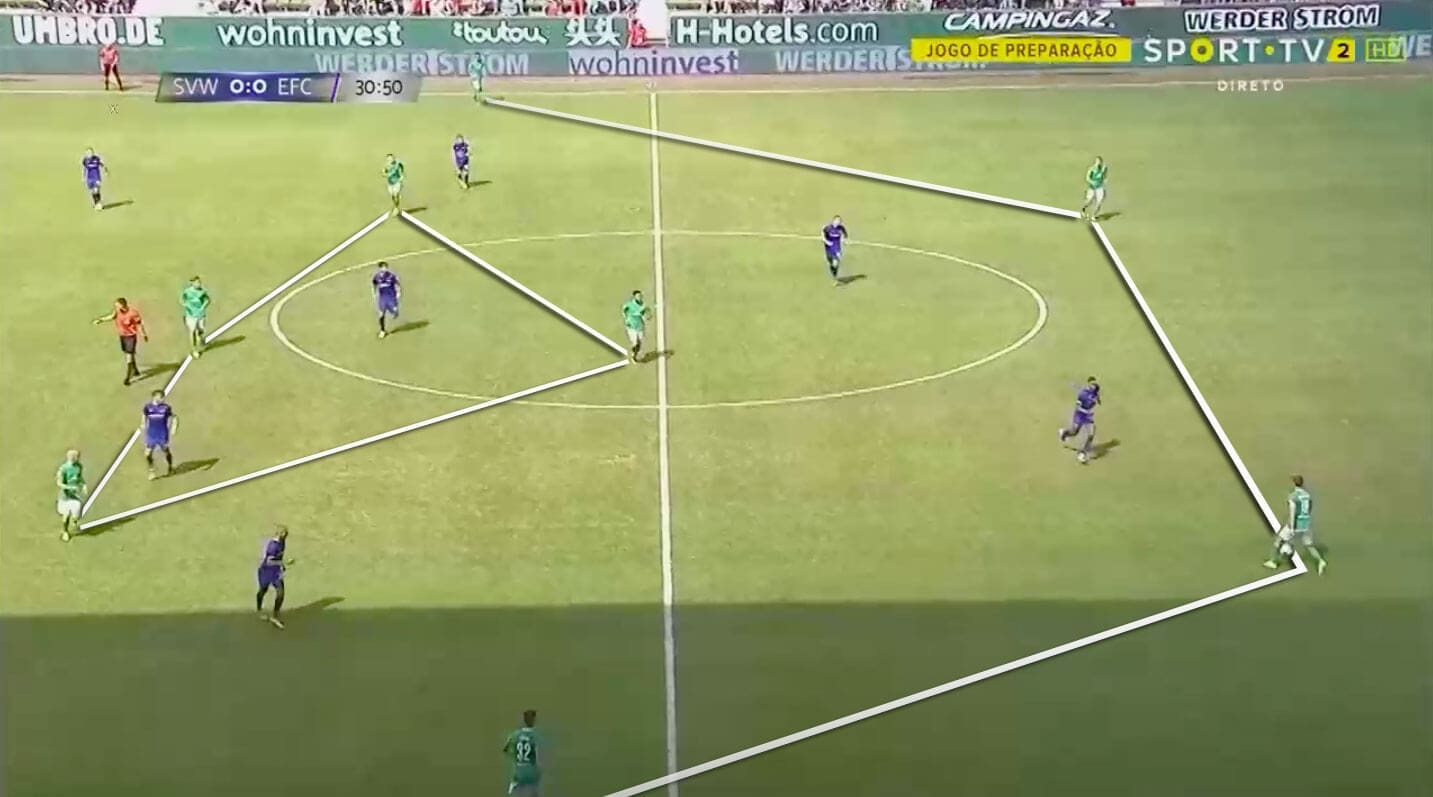
As you can see above, Werder created similar structures during pre-season against Everton.
The loss of Max Kruse: Blessing or Burden?
The loss of Max Kruse is both a blessing and a burden for Bremen.
On the one hand, Bremen highly benefited from Kruse’s offensive strengths. On the other hand, this is Werder’s chance to break their dependency on the German playmaker. Kruse scored and assisted most of Bremen’s goals and without him, Werder often lacked creativity within the attacking department. Going into the new season without Kruse though, offers Werder the chance to adjust their style of play.
It even seems that Yuya Osako might replace Kruse in a very similar way. The Japanese attacker has already shown that he is capable of using his technical abilities and spatial awareness as a false nine.
However, Kruse often helped Bremen during build-up and to progress up the pitch. Therefore, Kruse often dropped into his own half. Contrary to the German midfielder, Osako rather likes to be positioned between the opposition midfield and defence. As a consequence, Bremen needed to find new ways of progressing up the pitch.
One new feature of the Bundesliga side seems to be chipped balls towards the attackers. Either the central defenders or goalkeeper Pavlenka play chipped balls between the opposition midfield and defensive line. In Osako and Sargent, as well as new signing Füllkrug, Werder have players who can control and shield the ball and therewith enable the midfield to move up the pitch. Whereas Osako and Milot Rashica utilise their technical abilities, Sargent and Füllkrug make use of their robustness. The winner of the pre-season might be US youngster Josh Sargent. The talented striker showed convincing performances in the wide forward position.
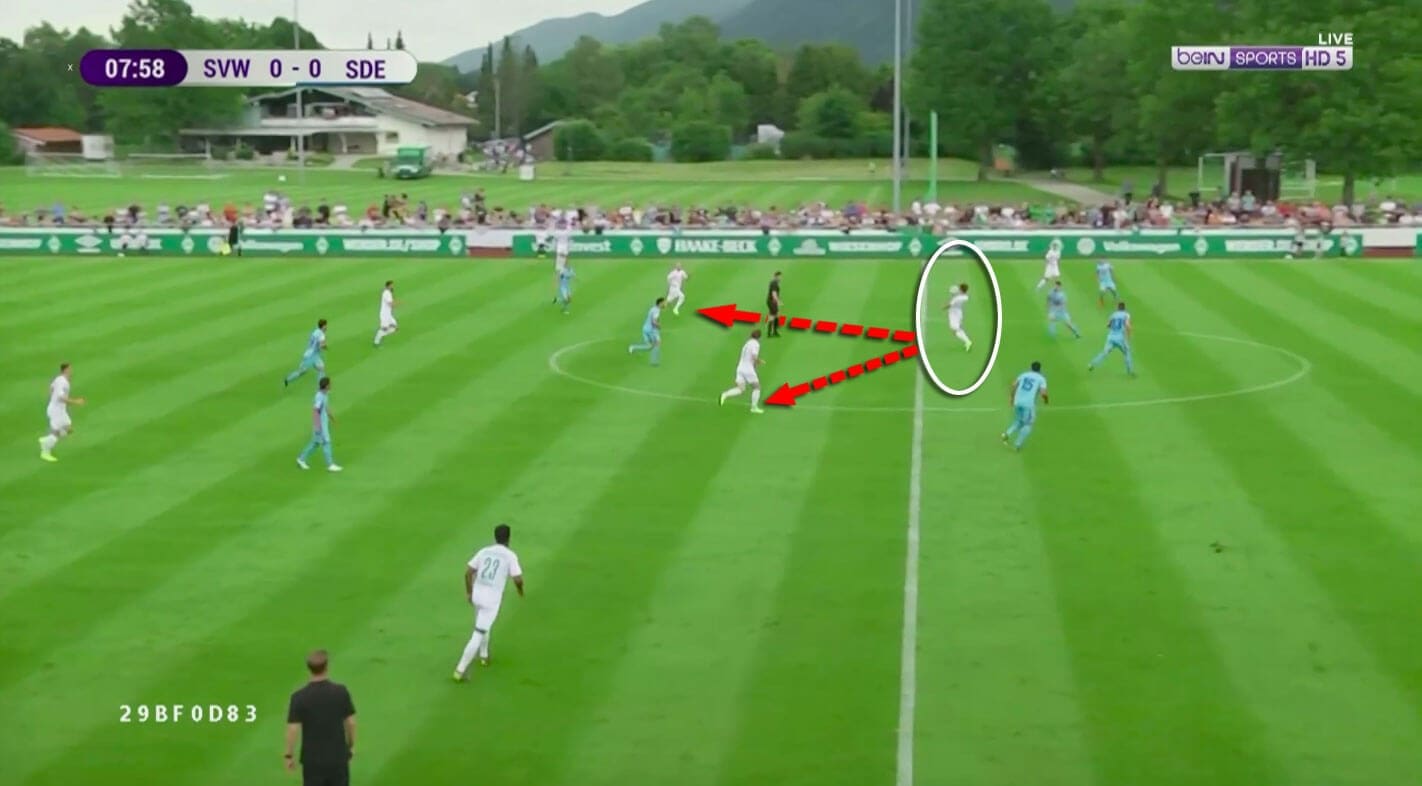
Playing these chipped balls in their pre-season matches, their narrow midfield allowed Bremen to win second balls and reduce the risk of being caught in a dangerous counter-attack in the centre.
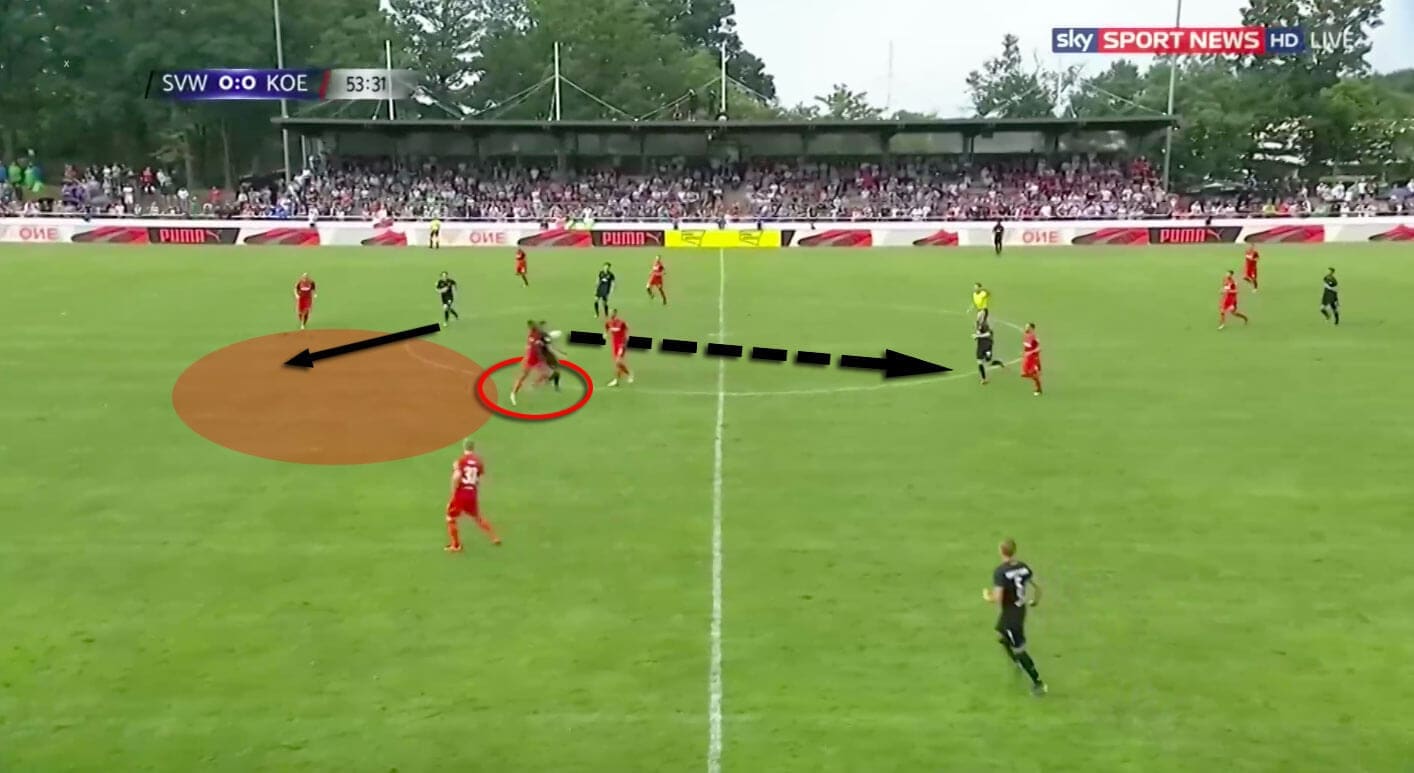
In the above-displayed scenario, Werder score a goal against Köln after Rashica laid the ball off to Klaassen who then used a third man combination to play towards the attacker Sargent.
Werder’s attacking patterns
According to Kohfeldt, one of Werder’s main aspects during pre-season training was the creation of chances with deep runs.
And it took some time but the players finally translated Kohfeldt’s tactics onto the pitch. Their fourth goal against SD Eibar for instance resulted from a pattern which Kohfeldt demands of his players. Whenever a central midfielder receives the ball in an open body shape, there needs to be players, especially on the ball far side, who run into space behind the opposition backline. In this case, pivot Sahin could play the chipped ball nearly blindly and therewith break the opposition last line.
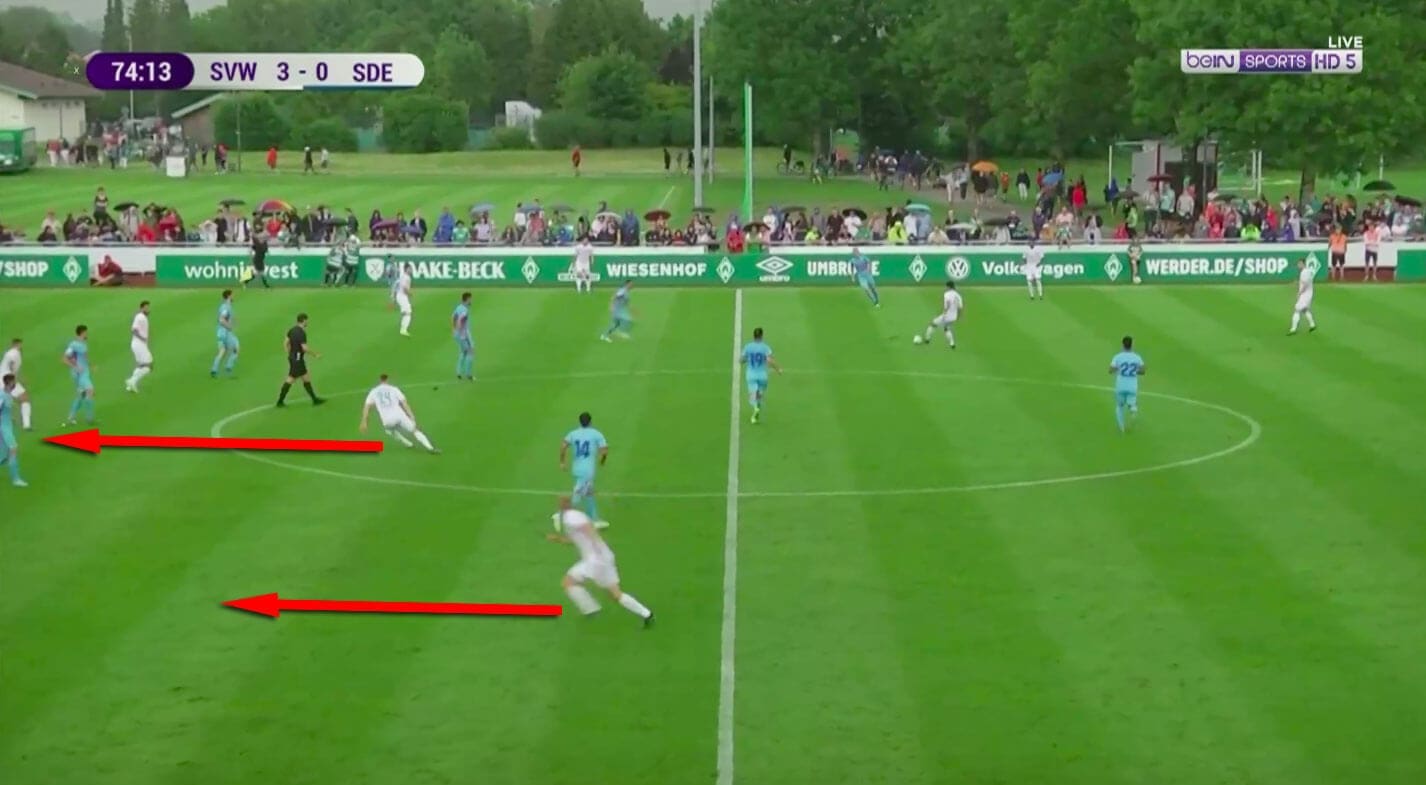
However, the 36-year-old coach also wants his players to focus on establishing a structure which enables them to stop threatening counter-attacks during possession phases. In case of a loss of the ball, Werder need to have several players behind the ball. Their central defenders aim at being in positions to defend the opposition attackers. Meaning they position themselves between the opponent and the goal. Preparing these structures to prevent counter-attacks will be key for Bremen in 2019/20 as Kohfeldt wants his side to be active and also take over possession. But that also means that sides with inferior individual quality might bank on a solid defence and fast counter-attacks.
Similar to their style of play in a 4-3-3 with Kruse as a false nine in 2017/18, in 2019/20 the false nine Osako might drop into central midfield from time to time. This would open up gaps for either progressive runs from advanced midfielders or diagonal runs into space behind the opposition defence from the attackers.
Furthermore, we might see more crosses from Werder in the future. As Niclas Füllkrug is a robust striker who has great heading abilities, Bremen’s full-backs could serve more crosses in 2019/20. And even attackers Yuya Osako as well as Josh Sargent have already proven their heading abilities.
Versatile build-up phase
Florian Kohfeldt wants his side to be more versatile during build-up in 2019/20. Therefore, Bremen played with several different approaches during pre-season. Instead of building up with two central defenders, Bremen often formed a back three during build-up. However, as Bremen usually use back four formations, this affords one of their full-backs to stay in the back while the other one pushes high up the pitch.
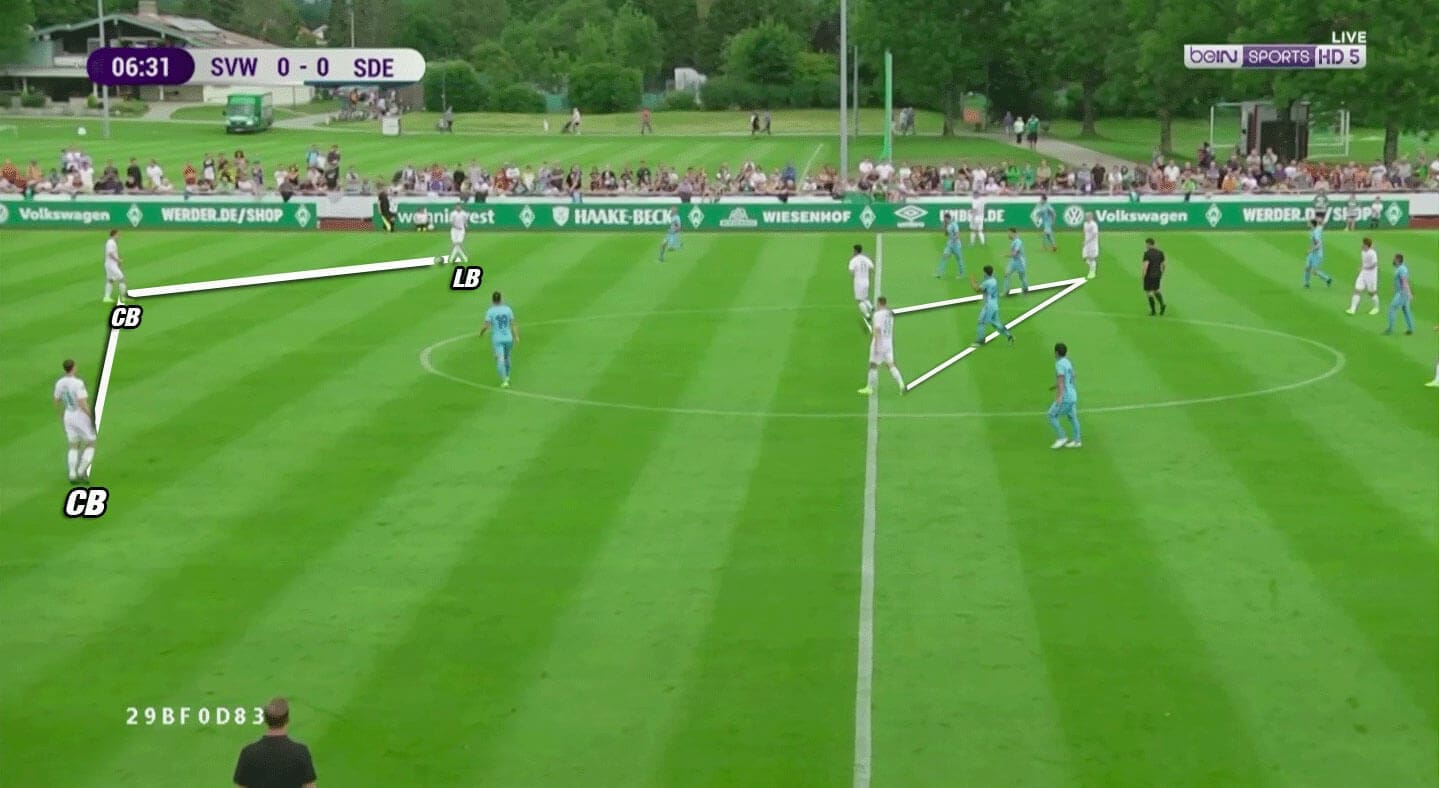
Against Eibar, left-back Marco Friedl stayed in the first build-up line. Meanwhile right-back Theodor Gebre Selassie positioned himself higher up the pitch. And the position of the left central defender in a line of three obviously does suit the abilities of the Austrian defender. His passing abilities allow Bremen to play line breaking passes from the back. In the full-back position, Friedl sometimes missed dribbling qualities in 1v1 situations when moving up the line. Having the whole pitch in front of him when playing out as a part of the back three, Friedl can make more use of his vision.
As a consequence, left winger Milot Rashica needed to stay wide while right winger Josh Sargent was allowed to tuck inside and act as a striker next to Osako. Only within the last third, Rashica also cut inside.
In front of the backline, Nuri Sahin is supposed to pull the strings as a holding midfielder. Maximilian Eggestein and Davy Klaassen both act as central advanced midfielders although Eggestein also likes to drop next to Sahin at times. Therewith, Werder create a 3-5-2 structure in possession.
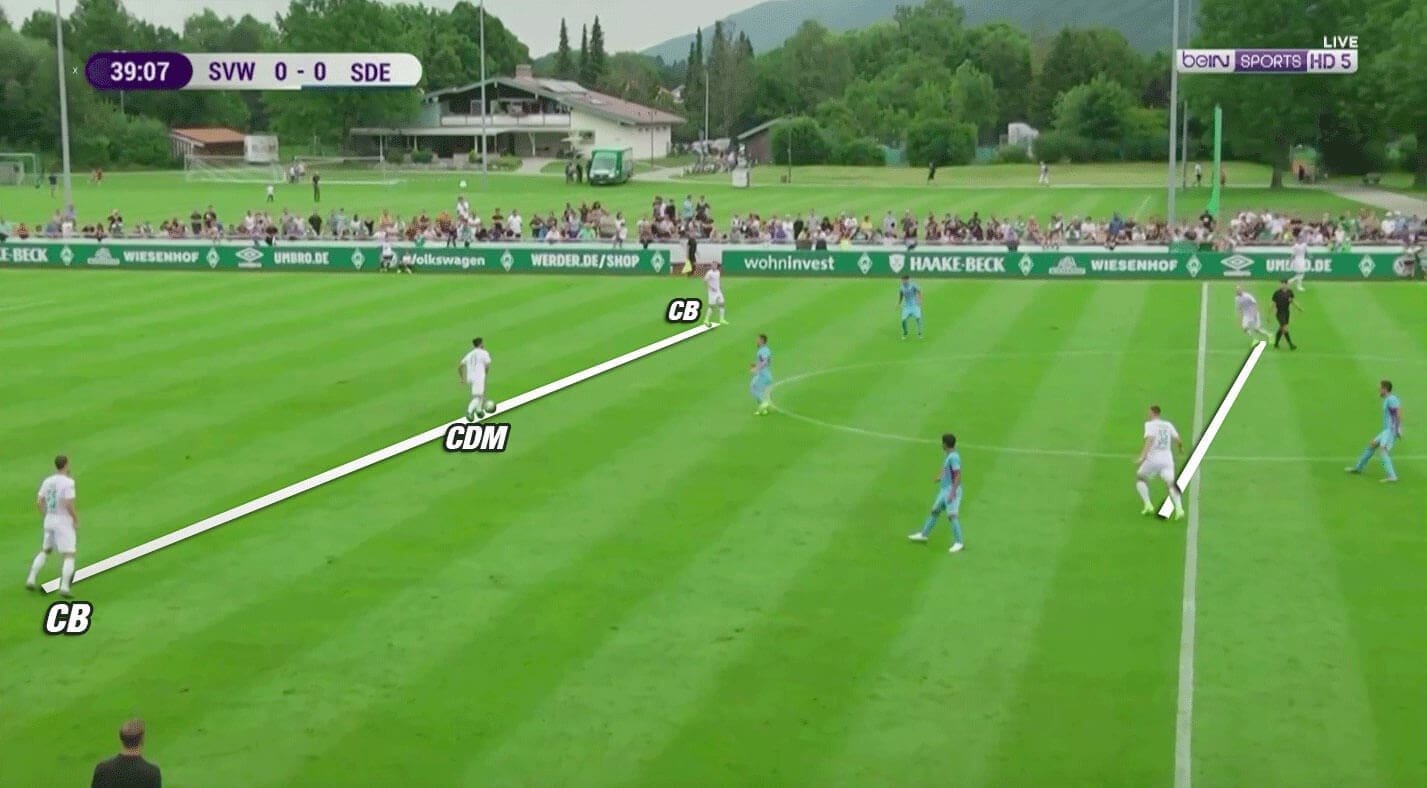
Another way of creating a back three in possession has been to let Sahin drop between both central defenders. Different to Werder’s 3-5-2 structure, the midfield then entails a double pivot comprising of Eggestein and Klaasen. This allows both wingers to tuck inside as the full-backs push up the line on either side simultaneously. As a result, Rashica and Sargent can attack both down the half-spaces in a 3-4-3 shape.
But Bremen’s ability to stay within their back four system during the possession phase with rather narrow wingers forming a 4-3-3 makes Kohfeldt’s side less predictable and therewith difficult to defend.
Defensive phase
When defending, Bremen recently preferred a solid 4-4-2 block or a variant of that system which forced the opposition outside. Whenever the opposition played square passes or back passes, Bremen tried to push into a block around the halfway-line while their real press started when the opposition full-back received the ball at the sideline. In this case, Werder used the advantage of pressing with two attackers and attempted to prevent any switch of play.
Against Eibar, Bremen defended in a 4-4-1-1 as one can see below.
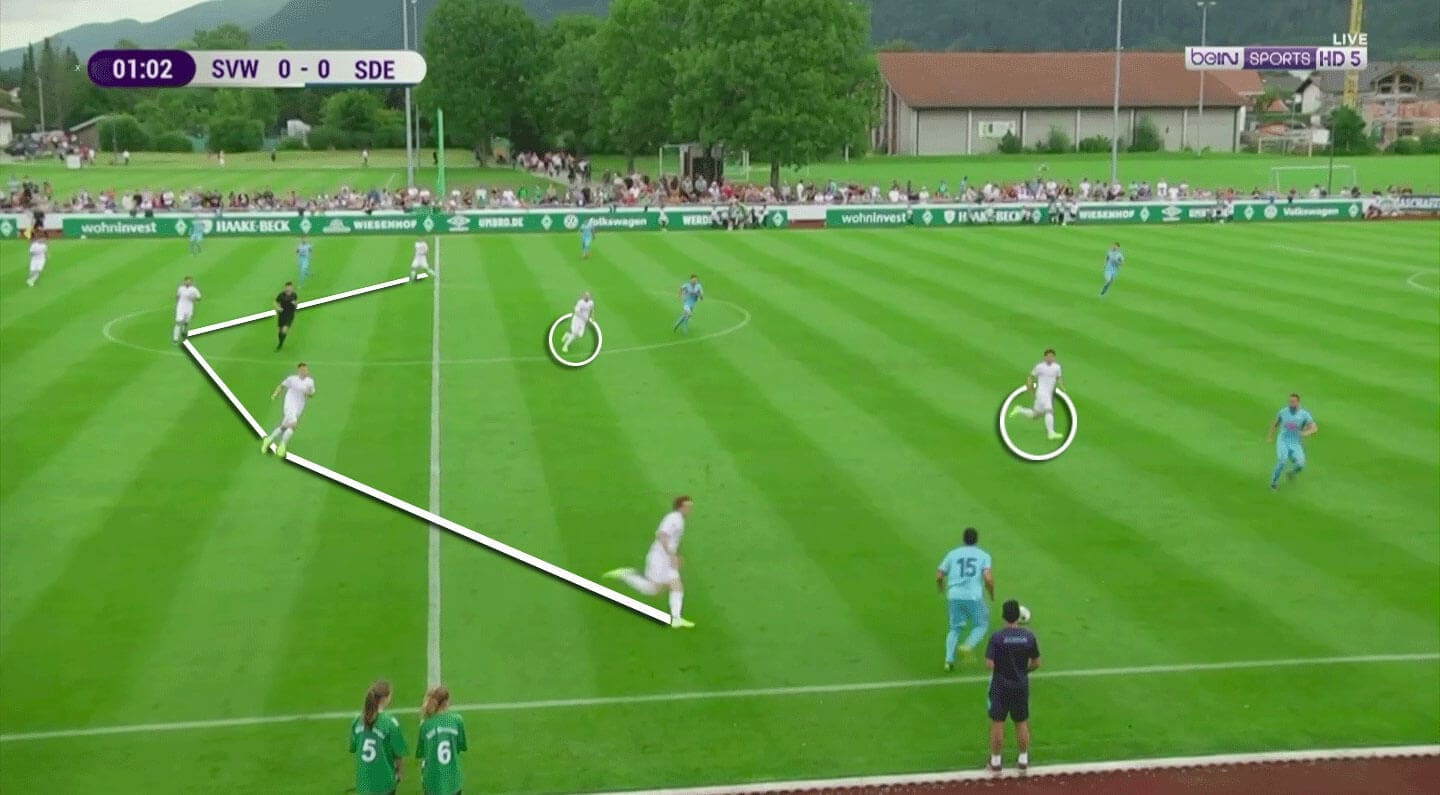
But despite Bremen’s mid-blocks during pre-season, it is likely that Kohfeldt will adjust the defending approach depending on the opposition in the Bundesliga. Therefore, it remains to be seen how Werder will set up on the first Bundesliga matchday against Düsseldorf.
Counter-attacks
In 2019/20 Werder Bremen will probably also be a threatening side when counter-attacking. Especially with Sargent and Rashica starting from wide positions, Werder offers a lot of pace to penalise high opposition full-backs.
Whereas Sargent might be more of an option against sides which like to possess the ball. Attacker Niclas Füllkrug might be of huge help against opponents which defend rather low as his presence within the penalty area will be needed.
Therefore, it is likely that Werder might have a decrease in their possession rate in 2019/20. But that does not necessarily mean a loss of attacking threat.
Predicted lineup
There is no doubt that Czech Jiri Pavlenka will be lined up as Bremen’s goalkeeper. Bremen have been satisfied with being able to keep the keeper despite some offers from bigger clubs. Pavlenka could win several points for his team with incredible saves in either 1v1 situations or on the line. And although Pavlenka is not the greatest in terms of short passing, he can contribute to Werder’s build-up play with precise chipped diagonal balls towards Bremen’s full-backs.
New captain Niklas Moisander will play in the central defence while his possible partners Milos Veljkovic and Sebastian Langkamp are still injured. Marco Friedl, however, could play as a centre-back as well in case they do not recover in time. Full-backs Theodor Gebre Selassie and Ludwig Augustinsson are key players and will play important roles in 2019/20.
The midfield trio Nuri Sahin, Davy Klaassen and Maximilian Eggestein seem to be seeded in the first eleven, too. But Kevin Möhwald poses a sensible alternative in central midfield.
Up front, Yuya Osako as a false nine and Milot Rashica as one of the attackers will play a key role as well while Josh Sargent and Niclas Füllkrug will duel for the right-forward position within the attack.
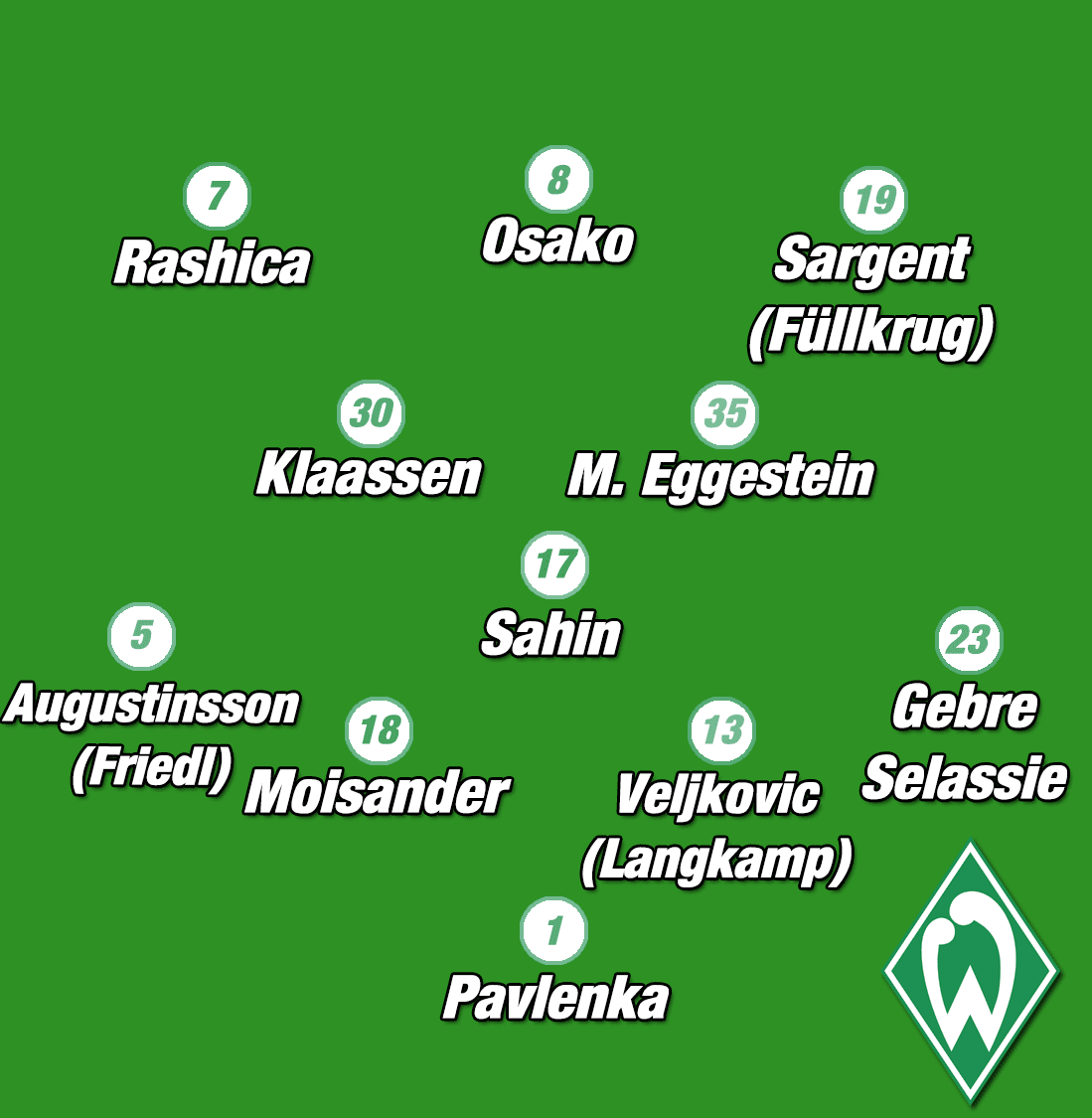
Conclusion
To sum up, our analysis has shown that Werder Bremen have a clear plan on how to fill the gap that Max Kruse left within the attacking department and how to fix some of the defensive issues that appeared in 2018/19.
Our scout report on Werder Bremen proves that Kohfeldt did not need to change much in terms of Bremen’s style of play but improved some tactical aspects. Therewith, Kohfeldt laid the foundation for a season in which Werder’s team mixed with promising talents and experienced players can further develop.

If you love tactical analysis, then you’ll love the digital magazines from totalfootballanalysis.com – a guaranteed 100+ pages of pure tactical analysis covering topics from the Premier League, Serie A, La Liga, Bundesliga and many, many more. Buy your copy of the July issue for just ₤4.99 here, or even better sign up for a ₤50 annual membership (12 monthly issues plus the annual review) right here.





Comments